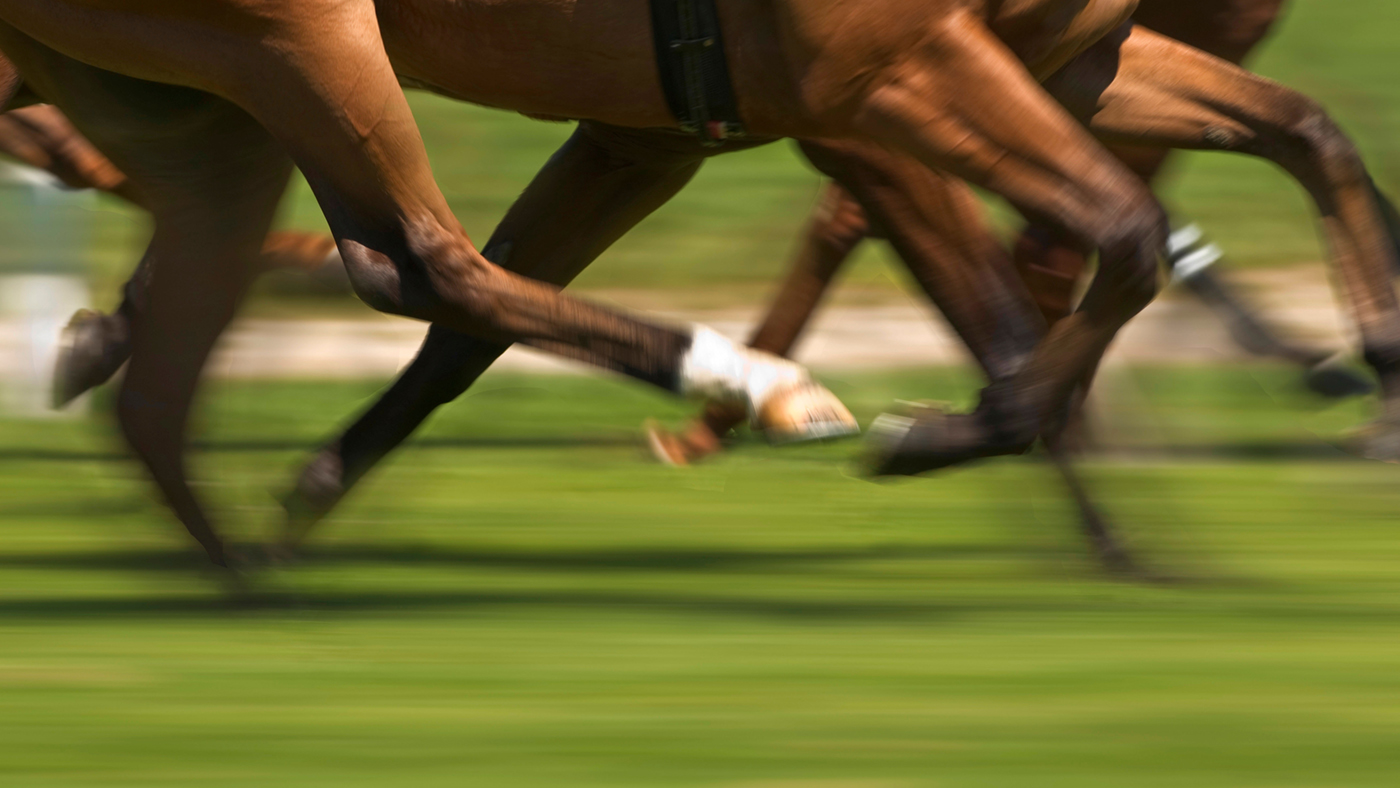Why might a horse become weak, wobbly or unable to stand? Dr Philip Ivens MRCVS discusses potential causes
ATAXIA refers to incoordination, which can affect one or more of the limbs and also the neck and body. While this complex condition can result from problems with the vestibular apparatus in the inner ear, or in a part of the brain called the cerebellum, ataxia often arises due to an issue in the spinal cord.
Spinal ataxia occurs when there is a lack of information coming up the horse’s spinal cord to tell his brain where his body parts are in space, and the state of muscle contraction at any one time. Ataxia is therefore not painful for the horse; rather, he has no sense of the position and movement of affected areas.
The hallmark of ataxia is inconsistency. Most orthopaedic lamenesses are consistently repeatable in any one gait, or on a particular surface, but with ataxia the gait changes all the time. A leg might swing out to the side or under the body; a joint might overflex, or a foot scuff or drag.
{"content":"PHA+SWYgaGUgdHJpcHMsIGFuIGF0YXhpYyBob3JzZSBtYXkgYmUgc2xvdyB0byBjb3JyZWN0IGhpbXNlbGYgYW5kIHBvdGVudGlhbGx5IGZhbGwuIEhpcyB0cnVuaywgbmVjayBvciBib3RoIG1pZ2h0IHN3YXkuIEhlIG1heSB0cmVhZCBvbiBoaW1zZWxmLCBvciBzdHJ1Z2dsZSB0byB0dXJuIOKAkyBvciBpbnN0ZWFkIG9mIGNyb3NzaW5nIGhpcyBsZWdzIHVuZGVybmVhdGggYXMgaGUgZG9lcyB0dXJuLCBoZSBzdGF5cyByb290ZWQgdG8gdGhlIHNwb3QsIHBpdm90aW5nIHdoaWxlIGhpcyBsZWdzIGV2ZW50dWFsbHkgY2F0Y2ggdXAuPC9wPgo8cD5BIGdyYWRpbmcgc3lzdGVtIGNhbiBkb2N1bWVudCB0aGUgc2V2ZXJpdHkgb2YgdGhlIHByb2JsZW0sIHN0YXJ0aW5nIHdpdGggYSB6ZXJvIGZvciBub3JtYWwgc3RyZW5ndGggYW5kIGNvb3JkaW5hdGlvbi4gR3JhZGUgb25lIGFwcGxpZXMgdG8gYSBob3JzZSB3aG8gd2Fsa3Mgbm9ybWFsbHkgaW4gYSBzdHJhaWdodCBsaW5lLCBidXQgc2hvd3MgYSBzbGlnaHQgZGVmaWNpdCB3aGVuIHdhbGtpbmcgb24gdGlnaHQgY2lyY2xlcyBvciB3aXRoIGhpcyBoZWFkIGV4dGVuZGVkLiBIZSBtYXkgYWxzbyBzd2F5IHdoZW4gcHVsbGVkIGJ5IHRoZSB0YWlsLjwvcD4KPHA+PGRpdiBjbGFzcz0iYWQtY29udGFpbmVyIGFkLWNvbnRhaW5lci0tbW9iaWxlIj48ZGl2IGlkPSJwb3N0LWlubGluZS0yIiBjbGFzcz0iaXBjLWFkdmVydCI+PC9kaXY+PC9kaXY+PHNlY3Rpb24gaWQ9ImVtYmVkX2NvZGUtMzEiIGNsYXNzPSJoaWRkZW4tbWQgaGlkZGVuLWxnIHMtY29udGFpbmVyIHN0aWNreS1hbmNob3IgaGlkZS13aWRnZXQtdGl0bGUgd2lkZ2V0X2VtYmVkX2NvZGUgcHJlbWl1bV9pbmxpbmVfMiI+PHNlY3Rpb24gY2xhc3M9InMtY29udGFpbmVyIGxpc3RpbmctLXNpbmdsZSBsaXN0aW5nLS1zaW5nbGUtc2hhcmV0aHJvdWdoIGltYWdlLWFzcGVjdC1sYW5kc2NhcGUgZGVmYXVsdCBzaGFyZXRocm91Z2gtYWQgc2hhcmV0aHJvdWdoLWFkLWhpZGRlbiI+DQogIDxkaXYgY2xhc3M9InMtY29udGFpbmVyX19pbm5lciI+DQogICAgPHVsPg0KICAgICAgPGxpIGlkPSJuYXRpdmUtY29udGVudC1tb2JpbGUiIGNsYXNzPSJsaXN0aW5nLWl0ZW0iPg0KICAgICAgPC9saT4NCiAgICA8L3VsPg0KICA8L2Rpdj4NCjwvc2VjdGlvbj48L3NlY3Rpb24+PC9wPgo8cD5BIG1pbGQgaW5jcmVhc2UgaW4gbXVzY2xlIHRvbmUgb3Igd2Vha25lc3MgaW4gYWxsIGZvdXIgbGltYnMsIHdpdGggYXRheGlhIGF0IGFsbCB0aW1lcyDigJMgZXNwZWNpYWxseSBkdXJpbmcgdGhlIG1hbmlwdWxhdGlvbnMgbWVudGlvbmVkIOKAkyBpcyBncmFkZWQgdHdvLCB3aGlsZSBncmFkZSB0aHJlZSBkZW5vdGVzIGEgbW9yZSBtYXJrZWQgaW5jcmVhc2UgaW4gc3RpZmZuZXNzIGFuZCBvYnZpb3VzIGF0YXhpYSwgd2l0aCBhIHRlbmRlbmN5IHRvIGJ1Y2tsZSBhbmQgZmFsbCB3aGlsZSBiZWluZyBjaXJjbGVkIHZpZ29yb3VzbHksIGJhY2tlZCB1cCBvciBzd2F5ZWQuIEEgZ3JhZGUgZm91ciBjYXNlIHdpbGwgc3BvbnRhbmVvdXNseSB0cmlwLCBzdHVtYmxlIGFuZCBmYWxsOyBhdCBncmFkZSBmaXZlLCB0aGUgaG9yc2UgaXMgcmVjdW1iZW50IGFuZCB1bmFibGUgdG8gc3RhbmQuPC9wPgo8cD48aW1nIGZldGNocHJpb3JpdHk9ImhpZ2giIGRlY29kaW5nPSJhc3luYyIgY2xhc3M9Imxhenlsb2FkIGJsdXItdXAgYWxpZ25ub25lIHNpemUtZnVsbCB3cC1pbWFnZS03NDI4NjkiIGRhdGEtcHJvY2Vzc2VkIHNyYz0iaHR0cHM6Ly9rZXlhc3NldHMudGltZWluY3VrLm5ldC9pbnNwaXJld3AvbGl2ZS93cC1jb250ZW50L3VwbG9hZHMvc2l0ZXMvMTQvMjAxNy8wMy9uZXctaGgtcGxhY2Vob2xkZXItMjAweDIwMC5wbmciIGRhdGEtc3JjPSJodHRwczovL2tleWFzc2V0cy50aW1laW5jdWsubmV0L2luc3BpcmV3cC9saXZlL3dwLWNvbnRlbnQvdXBsb2Fkcy9zaXRlcy8xNC8yMDIxLzA0L0hBSDMwMS52ZXRfLmRzY185ODA1XzIyODg5MTc2Ml8zNDU3MzA3NzFfdGlfYXJjaGl2ZS5qcGciIGFsdD0iVmV0IChLYXJlbiBDb29tYmUpIGNoZWNraW5nIGFuZCBleGFtaW5pbmcgYSBob3JzZTsgdHVybmluZyBhIGNpcmNsZTsgZmVlbGluZyBpdHMgYmFjazsgbG9va2luZyBhdCBpdHMgZmVldCIgd2lkdGg9IjE0MDAiIGhlaWdodD0iMTg3MiIgZGF0YS1zaXplcz0iYXV0byIgZGF0YS1zcmNzZXQ9Imh0dHBzOi8va2V5YXNzZXRzLnRpbWVpbmN1ay5uZXQvaW5zcGlyZXdwL2xpdmUvd3AtY29udGVudC91cGxvYWRzL3NpdGVzLzE0LzIwMjEvMDQvSEFIMzAxLnZldF8uZHNjXzk4MDVfMjI4ODkxNzYyXzM0NTczMDc3MV90aV9hcmNoaXZlLmpwZyAxNDAwdywgaHR0cHM6Ly9rZXlhc3NldHMudGltZWluY3VrLm5ldC9pbnNwaXJld3AvbGl2ZS93cC1jb250ZW50L3VwbG9hZHMvc2l0ZXMvMTQvMjAyMS8wNC9IQUgzMDEudmV0Xy5kc2NfOTgwNV8yMjg4OTE3NjJfMzQ1NzMwNzcxX3RpX2FyY2hpdmUtMTUweDIwMC5qcGcgMTUwdywgaHR0cHM6Ly9rZXlhc3NldHMudGltZWluY3VrLm5ldC9pbnNwaXJld3AvbGl2ZS93cC1jb250ZW50L3VwbG9hZHMvc2l0ZXMvMTQvMjAyMS8wNC9IQUgzMDEudmV0Xy5kc2NfOTgwNV8yMjg4OTE3NjJfMzQ1NzMwNzcxX3RpX2FyY2hpdmUtMjk5eDQwMC5qcGcgMjk5dywgaHR0cHM6Ly9rZXlhc3NldHMudGltZWluY3VrLm5ldC9pbnNwaXJld3AvbGl2ZS93cC1jb250ZW50L3VwbG9hZHMvc2l0ZXMvMTQvMjAyMS8wNC9IQUgzMDEudmV0Xy5kc2NfOTgwNV8yMjg4OTE3NjJfMzQ1NzMwNzcxX3RpX2FyY2hpdmUtNzV4MTAwLmpwZyA3NXcsIGh0dHBzOi8va2V5YXNzZXRzLnRpbWVpbmN1ay5uZXQvaW5zcGlyZXdwL2xpdmUvd3AtY29udGVudC91cGxvYWRzL3NpdGVzLzE0LzIwMjEvMDQvSEFIMzAxLnZldF8uZHNjXzk4MDVfMjI4ODkxNzYyXzM0NTczMDc3MV90aV9hcmNoaXZlLTExNDl4MTUzNi5qcGcgMTE0OXcsIGh0dHBzOi8va2V5YXNzZXRzLnRpbWVpbmN1ay5uZXQvaW5zcGlyZXdwL2xpdmUvd3AtY29udGVudC91cGxvYWRzL3NpdGVzLzE0LzIwMjEvMDQvSEFIMzAxLnZldF8uZHNjXzk4MDVfMjI4ODkxNzYyXzM0NTczMDc3MV90aV9hcmNoaXZlLTIzOXgzMjAuanBnIDIzOXcsIGh0dHBzOi8va2V5YXNzZXRzLnRpbWVpbmN1ay5uZXQvaW5zcGlyZXdwL2xpdmUvd3AtY29udGVudC91cGxvYWRzL3NpdGVzLzE0LzIwMjEvMDQvSEFIMzAxLnZldF8uZHNjXzk4MDVfMjI4ODkxNzYyXzM0NTczMDc3MV90aV9hcmNoaXZlLTQ2NHg2MjAuanBnIDQ2NHcsIGh0dHBzOi8va2V5YXNzZXRzLnRpbWVpbmN1ay5uZXQvaW5zcGlyZXdwL2xpdmUvd3AtY29udGVudC91cGxvYWRzL3NpdGVzLzE0LzIwMjEvMDQvSEFIMzAxLnZldF8uZHNjXzk4MDVfMjI4ODkxNzYyXzM0NTczMDc3MV90aV9hcmNoaXZlLTY4OHg5MjAuanBnIDY4OHcsIGh0dHBzOi8va2V5YXNzZXRzLnRpbWVpbmN1ay5uZXQvaW5zcGlyZXdwL2xpdmUvd3AtY29udGVudC91cGxvYWRzL3NpdGVzLzE0LzIwMjEvMDQvSEFIMzAxLnZldF8uZHNjXzk4MDVfMjI4ODkxNzYyXzM0NTczMDc3MV90aV9hcmNoaXZlLTkxMngxMjIwLmpwZyA5MTJ3LCBodHRwczovL2tleWFzc2V0cy50aW1laW5jdWsubmV0L2luc3BpcmV3cC9saXZlL3dwLWNvbnRlbnQvdXBsb2Fkcy9zaXRlcy8xNC8yMDIxLzA0L0hBSDMwMS52ZXRfLmRzY185ODA1XzIyODg5MTc2Ml8zNDU3MzA3NzFfdGlfYXJjaGl2ZS0xMjEyeDE2MjAuanBnIDEyMTJ3LCBodHRwczovL2tleWFzc2V0cy50aW1laW5jdWsubmV0L2luc3BpcmV3cC9saXZlL3dwLWNvbnRlbnQvdXBsb2Fkcy9zaXRlcy8xNC8yMDIxLzA0L0hBSDMwMS52ZXRfLmRzY185ODA1XzIyODg5MTc2Ml8zNDU3MzA3NzFfdGlfYXJjaGl2ZS0zNTR4NDcyLmpwZyAzNTR3IiBzaXplcz0iKG1heC13aWR0aDogMTQwMHB4KSAxMDB2dywgMTQwMHB4IiAvPjwvcD4KPGgzPlNJR05BTCBQUk9CTEVNUzwvaDM+CjxwPkNFUlRBSU4gZGV2ZWxvcG1lbnRhbCBjb25kaXRpb25zIHByZXNlbnQgYXQgYmlydGggY2FuIGNhdXNlIGF0YXhpYS4gVGhlc2UgaW5jbHVkZSBhYm5vcm1hbCB1bmRlcmRldmVsb3BtZW50IG9mIHRoZSBjZXJlYmVsbHVtLCBjYWxsZWQgY2VyZWJlbGxhciBhYmlvdHJvcGh5LCBhbmQgYWJub3JtYWwgZm9ybWF0aW9uIG9mIHRoZSBmaXJzdCBhbmQgc2Vjb25kIGNlcnZpY2FsIHZlcnRlYnJhZSwgdGVybWVkIGF0bGFudG9heGlhbCBtYWxmb3JtYXRpb24uPC9wPgo8ZGl2IGNsYXNzPSJhZC1jb250YWluZXIgYWQtY29udGFpbmVyLS1tb2JpbGUiPjxkaXYgaWQ9InBvc3QtaW5saW5lLTMiIGNsYXNzPSJpcGMtYWR2ZXJ0Ij48L2Rpdj48L2Rpdj4KPHA+VGhlIGRlZ2VuZXJhdGl2ZSBjb25kaXRpb24gY2VydmljYWwgdmVydGVicmFsIG1hbGZvcm1hdGlvbiAoQ1ZNKSwgb3Igd29iYmxlcnMgc3luZHJvbWUsIGxlYWRzIHRvIGNvbXByZXNzaW9uIG9mIHRoZSBzcGluYWwgY29yZCBhbmQgaW5oaWJpdHMgaXRzIGFiaWxpdHkgdG8gY2FycnkgbWVzc2FnZXMgdG8gdGhlIGJyYWluLiBBbmQgc3lub3ZpYWwgY3lzdHMsIHZlcnRlYnJhbCBmcmFjdHVyZSBhbmQgZGlmZmVyZW50IHR5cGVzIG9mIHR1bW91ciDigJMgbWVsYW5vbWEsIHBsYXNtYSBjZWxsIG15ZWxvbWEgYW5kIGx5bXBob21hIOKAkyBjYW4gcHJlc3Mgb24gdGhlIG5lcnZlcyBhbmQgc3BpbmFsIGNvcmQuPC9wPgo8cD5JbmZlY3Rpb3VzIGRpc2Vhc2UgY2FuIHJlc3VsdCBpbiBhdGF4aWE6IHZpcnVzZXMsIHN1Y2ggYXMgdGhlIGVxdWluZSBoZXJwZXMgdmlydXMtMSAoRUhWLTEsIHNlZSBib3gpLCB3aGljaCBpcyBlbmRlbWljIGluIHRoZSBVSywgYW5kIHRoZSBleG90aWMgZGlzZWFzZSBXZXN0IE5pbGUgdmlydXMsIHdoaWNoIGlzIGJlY29taW5nIGVzdGFibGlzaGVkIGluIGNlbnRyYWwgRXVyb3BlIGFuZCBsaWtlbHkgdG8gY29tZSB0byB0aGUgVUsgYXQgc29tZSBwb2ludC4gQmFjdGVyaWFsIG1lbmluZ2l0aXMsIGRpc2Vhc2VzIGNhdXNlZCBieSBwcm90b3pvYSDigJMgc2VlbiBtYWlubHkgaW4gbm9ydGggQW1lcmljYSDigJMgYW5kIHBhcmFzaXRpYyBjYXVzZXMgaGF2ZSBhbHNvIGJlZW4gZG9jdW1lbnRlZC48L3A+CjxkaXYgY2xhc3M9ImFkLWNvbnRhaW5lciBhZC1jb250YWluZXItLW1vYmlsZSI+PGRpdiBpZD0icG9zdC1pbmxpbmUtNCIgY2xhc3M9ImlwYy1hZHZlcnQiPjwvZGl2PjwvZGl2Pgo8cD5BdGF4aWEgY2FuIGJlIGNhdXNlZCBieSBhIGxvbmcgbGlzdCBvZiB0b3hpbnMsIHRoZSBtb3N0IGNvbW1vbiBvZiB3aGljaCBpbiB0aGUgVUsgaXMgc2V2ZXJlIG5ldHRsZSByYXNoLiBIZWF2eSBtZXRhbHMgc3VjaCBhcyBsZWFkIGFuZCBhcnNlbmljIG1heSBiZSB0byBibGFtZSwgb3IgY2VydGFpbiB0aGVyYXBldXRpYyBkcnVncyBpZiB1c2VkIGluYXBwcm9wcmlhdGVseSDigJMgaW9ub3Bob3JlcywgZm9yIGV4YW1wbGUsIHN1Y2ggYXMgbW9uZW5zaW4sIGZvdW5kIGluIGNhdHRsZSBhbmQgcG91bHRyeSBmZWVkLjwvcD4KPHA+UmVhY2hpbmcgYSBkaWFnbm9zaXMgYmVnaW5zIHdpdGggY29uc2lkZXJhdGlvbiBvZiB0aGUgaG9yc2XigJlzIGFnZSBhbmQgYnJlZWQgYW5kIGEgdGhvcm91Z2ggZXhhbWluYXRpb24gb2YgaGlzIGhpc3RvcnkuIEhhcyBoZSBmYWxsZW4sIGZvciBleGFtcGxlLCBvciBhcmUgdGhlcmUgc3RpbmdpbmcgbmV0dGxlcyBpbiBoaXMgZmllbGQ\/PC9wPgo8ZGl2IGNsYXNzPSJhZC1jb250YWluZXIgYWQtY29udGFpbmVyLS1tb2JpbGUiPjxkaXYgaWQ9InBvc3QtaW5saW5lLTUiIGNsYXNzPSJpcGMtYWR2ZXJ0Ij48L2Rpdj48L2Rpdj4KPHA+QSByb3V0aW5lIGV4YW1pbmF0aW9uIHdpbGwgYXNzZXNzIGZhY3RvcnMgc3VjaCBhcyBoZWFydCByYXRlLCByZXNwaXJhdG9yeSByYXRlIGFuZCB0ZW1wZXJhdHVyZSwgdG8gaWRlbnRpZnkgYW55IG90aGVyIHBoeXNpY2FsIGFibm9ybWFsaXRpZXMgdGhhdCBtYXkgY29udHJpYnV0ZSB0byBvciBiZSBwYXJ0IG9mIHRoZSBuZXVyb2xvZ2ljYWwgcHJvYmxlbS4gRm9yIGV4YW1wbGUsIGl0IGlzIHBvc3NpYmxlIGZvciBhIGhvcnNlIHdpdGggYSBmb290IGFic2Nlc3MgdG8gbG9vayBhdGF4aWMgb3IgZm9yIHByaW1hcnkgbXVzY2xlIGRpc2Vhc2UgdG8gY2F1c2Ugd2Vha25lc3MgYW5kIHNpbWlsYXIgc2lnbnMuIFBlcmhhcHMgb3RoZXIgYm9keSBzeXN0ZW1zIGFyZSBpbnZvbHZlZCwgc3VjaCBhcyB0aGUgc2tpbi4gSWYgZmV2ZXIgaXMgcHJlc2VudCwgYW4gaW5mZWN0aW91cyBjYXVzZSBiZWNvbWVzIG1vcmUgbGlrZWx5LjwvcD4KPHA+QSBuZXVyb2xvZ2ljYWwgZXhhbWluYXRpb24gdGhlbiBmb2xsb3dzLCBjb21wcmlzaW5nIHRlc3RzIHRvIGlkZW50aWZ5IHRoZSBwYXJ0IG9mIHRoZSBuZXJ2b3VzIHN5c3RlbSB0aGF0IGlzIGFmZmVjdGVkLiBUaGlzIHByb2Nlc3MsIG5ldXJvbG9jYWxpc2F0aW9uLCBpcyBhIGtleSBwYXJ0IG9mIHBpbnBvaW50aW5nIHRoZSBjYXVzZSBhbmQgaXMgdXNlZCB0byBkZXRlcm1pbmUgd2hldGhlciB0aGUgc3BpbmFsIGNvcmQgYWxvbmUgaXMgaW52b2x2ZWQsIG9yIGlmIHRoZSBicmFpbiBhbmQgdGhlIHBlcmlwaGVyYWwgbmVydmVzIGFyZSBhbHNvIGltcGxpY2F0ZWQuIFRoZSBkaXNlYXNlIG1heSBiZSBmb2NhbCDigJMgY2VudHJlZCBpbiBvbmUgbG9jYXRpb24g4oCTIG9yIG11bHRpZm9jYWwsIGFmZmVjdGluZyBtdWx0aXBsZSBwbGFjZXMuPC9wPgo8cD5CYXNlZCBvbiB0aGVzZSBmaW5kaW5ncywgYXV4aWxpYXJ5IGRpYWdub3N0aWMgdGVzdHMgbWF5IGluY2x1ZGUgYSBibG9vZCBjZWxsIGNvdW50LCB3aXRoIHNlcnVtIGJpb2NoZW1pc3RyeSwgdG8gbG9vayBmb3Igc2lnbnMgb2YgaW5mbGFtbWF0aW9uIGFuZCBvdGhlciBib2R5IHN5c3RlbSBpbnZvbHZlbWVudC4gRGlhZ25vc3RpYyBpbWFnaW5nIGlzIGJlY29taW5nIGluY3JlYXNpbmdseSBoZWxwZnVsOyB0aGUgcXVhbGl0eSBvZiBYLXJheXMgb2YgdGhlIG5lY2sgaGFzIGltcHJvdmVkLCB3aGlsZSBhZHZhbmNlZCB0ZWNobmlxdWVzIHN1Y2ggYXMgY29tcHV0ZWQgdG9tb2dyYXBoeSAoQ1QpIGFuZCBtYWduZXRpYyByZXNvbmFuY2UgaW1hZ2luZyAoTVJJKSBhcmUgZmVhc2libGUgZm9yIGF0IGxlYXN0IHBhcnQgb2YgdGhlIHRvcCBvZiB0aGUgbmVjay48L3A+CjxwPlNhbXBsaW5nIHRoZSBjZXJlYnJhbCBzcGluYWwgZmx1aWQsIGVpdGhlciBhdCB0aGUgYXRsYW50by1vY2NpcGl0YWwgam9pbnQgKGp1c3QgYmVoaW5kIHRoZSBlYXJzKSBvciBpbiB0aGUgbHVtYm9zYWNyYWwgYXJlYSAoYmVoaW5kIHRoZSBzYWRkbGUpLCBpcyBwb3NzaWJsZSBhbmQgaW4gc29tZSBjYXNlcyBoZWxwZnVsLjwvcD4KPHA+PGRpdiBpZD0iYXR0YWNobWVudF83NDI4NzAiIHN0eWxlPSJ3aWR0aDogMTQxMHB4IiBjbGFzcz0id3AtY2FwdGlvbiBhbGlnbm5vbmUiPjxpbWcgZGVjb2Rpbmc9ImFzeW5jIiBhcmlhLWRlc2NyaWJlZGJ5PSJjYXB0aW9uLWF0dGFjaG1lbnQtNzQyODcwIiBjbGFzcz0ibGF6eWxvYWQgYmx1ci11cCBzaXplLWZ1bGwgd3AtaW1hZ2UtNzQyODcwIiBkYXRhLXByb2Nlc3NlZCBzcmM9Imh0dHBzOi8va2V5YXNzZXRzLnRpbWVpbmN1ay5uZXQvaW5zcGlyZXdwL2xpdmUvd3AtY29udGVudC91cGxvYWRzL3NpdGVzLzE0LzIwMTcvMDMvbmV3LWhoLXBsYWNlaG9sZGVyLTIwMHgyMDAucG5nIiBkYXRhLXNyYz0iaHR0cHM6Ly9rZXlhc3NldHMudGltZWluY3VrLm5ldC9pbnNwaXJld3AvbGl2ZS93cC1jb250ZW50L3VwbG9hZHMvc2l0ZXMvMTQvMjAyMS8wNC9IQUgzMDEudmV0Xy5wX2l2ZW5zX2NvbGxlY3Rpb25fb2ZfY2VyZWJyYWxfc3BpbmFsX2ZsdWlkX2ZyZWVfd29yZGluZy5qcGciIGFsdD0iIiB3aWR0aD0iMTQwMCIgaGVpZ2h0PSI3ODgiIGRhdGEtc2l6ZXM9ImF1dG8iIGRhdGEtc3Jjc2V0PSJodHRwczovL2tleWFzc2V0cy50aW1laW5jdWsubmV0L2luc3BpcmV3cC9saXZlL3dwLWNvbnRlbnQvdXBsb2Fkcy9zaXRlcy8xNC8yMDIxLzA0L0hBSDMwMS52ZXRfLnBfaXZlbnNfY29sbGVjdGlvbl9vZl9jZXJlYnJhbF9zcGluYWxfZmx1aWRfZnJlZV93b3JkaW5nLmpwZyAxNDAwdywgaHR0cHM6Ly9rZXlhc3NldHMudGltZWluY3VrLm5ldC9pbnNwaXJld3AvbGl2ZS93cC1jb250ZW50L3VwbG9hZHMvc2l0ZXMvMTQvMjAyMS8wNC9IQUgzMDEudmV0Xy5wX2l2ZW5zX2NvbGxlY3Rpb25fb2ZfY2VyZWJyYWxfc3BpbmFsX2ZsdWlkX2ZyZWVfd29yZGluZy0zMDB4MTY5LmpwZyAzMDB3LCBodHRwczovL2tleWFzc2V0cy50aW1laW5jdWsubmV0L2luc3BpcmV3cC9saXZlL3dwLWNvbnRlbnQvdXBsb2Fkcy9zaXRlcy8xNC8yMDIxLzA0L0hBSDMwMS52ZXRfLnBfaXZlbnNfY29sbGVjdGlvbl9vZl9jZXJlYnJhbF9zcGluYWxfZmx1aWRfZnJlZV93b3JkaW5nLTYzMHgzNTUuanBnIDYzMHcsIGh0dHBzOi8va2V5YXNzZXRzLnRpbWVpbmN1ay5uZXQvaW5zcGlyZXdwL2xpdmUvd3AtY29udGVudC91cGxvYWRzL3NpdGVzLzE0LzIwMjEvMDQvSEFIMzAxLnZldF8ucF9pdmVuc19jb2xsZWN0aW9uX29mX2NlcmVicmFsX3NwaW5hbF9mbHVpZF9mcmVlX3dvcmRpbmctMTM1eDc2LmpwZyAxMzV3LCBodHRwczovL2tleWFzc2V0cy50aW1laW5jdWsubmV0L2luc3BpcmV3cC9saXZlL3dwLWNvbnRlbnQvdXBsb2Fkcy9zaXRlcy8xNC8yMDIxLzA0L0hBSDMwMS52ZXRfLnBfaXZlbnNfY29sbGVjdGlvbl9vZl9jZXJlYnJhbF9zcGluYWxfZmx1aWRfZnJlZV93b3JkaW5nLTMyMHgxODAuanBnIDMyMHcsIGh0dHBzOi8va2V5YXNzZXRzLnRpbWVpbmN1ay5uZXQvaW5zcGlyZXdwL2xpdmUvd3AtY29udGVudC91cGxvYWRzL3NpdGVzLzE0LzIwMjEvMDQvSEFIMzAxLnZldF8ucF9pdmVuc19jb2xsZWN0aW9uX29mX2NlcmVicmFsX3NwaW5hbF9mbHVpZF9mcmVlX3dvcmRpbmctNjIweDM0OS5qcGcgNjIwdywgaHR0cHM6Ly9rZXlhc3NldHMudGltZWluY3VrLm5ldC9pbnNwaXJld3AvbGl2ZS93cC1jb250ZW50L3VwbG9hZHMvc2l0ZXMvMTQvMjAyMS8wNC9IQUgzMDEudmV0Xy5wX2l2ZW5zX2NvbGxlY3Rpb25fb2ZfY2VyZWJyYWxfc3BpbmFsX2ZsdWlkX2ZyZWVfd29yZGluZy05MjB4NTE4LmpwZyA5MjB3LCBodHRwczovL2tleWFzc2V0cy50aW1laW5jdWsubmV0L2luc3BpcmV3cC9saXZlL3dwLWNvbnRlbnQvdXBsb2Fkcy9zaXRlcy8xNC8yMDIxLzA0L0hBSDMwMS52ZXRfLnBfaXZlbnNfY29sbGVjdGlvbl9vZl9jZXJlYnJhbF9zcGluYWxfZmx1aWRfZnJlZV93b3JkaW5nLTEyMjB4Njg3LmpwZyAxMjIwdyIgc2l6ZXM9IihtYXgtd2lkdGg6IDE0MDBweCkgMTAwdncsIDE0MDBweCIgLz48cCBpZD0iY2FwdGlvbi1hdHRhY2htZW50LTc0Mjg3MCIgY2xhc3M9IndwLWNhcHRpb24tdGV4dCI+Q2VyZWJyYWwgc3BpbmFsIGZsdWlkIGlzIGNvbGxlY3RlZCB1bmRlciBnZW5lcmFsIGFuYWVzdGhlc2lhPC9wPjwvZGl2PjxiciAvPgo8ZGl2IGlkPSJhdHRhY2htZW50Xzc0Mjg3MyIgc3R5bGU9IndpZHRoOiAxNDEwcHgiIGNsYXNzPSJ3cC1jYXB0aW9uIGFsaWdubm9uZSI+PGltZyBkZWNvZGluZz0iYXN5bmMiIGFyaWEtZGVzY3JpYmVkYnk9ImNhcHRpb24tYXR0YWNobWVudC03NDI4NzMiIGNsYXNzPSJsYXp5bG9hZCBibHVyLXVwIHNpemUtZnVsbCB3cC1pbWFnZS03NDI4NzMiIGRhdGEtcHJvY2Vzc2VkIHNyYz0iaHR0cHM6Ly9rZXlhc3NldHMudGltZWluY3VrLm5ldC9pbnNwaXJld3AvbGl2ZS93cC1jb250ZW50L3VwbG9hZHMvc2l0ZXMvMTQvMjAxNy8wMy9uZXctaGgtcGxhY2Vob2xkZXItMjAweDIwMC5wbmciIGRhdGEtc3JjPSJodHRwczovL2tleWFzc2V0cy50aW1laW5jdWsubmV0L2luc3BpcmV3cC9saXZlL3dwLWNvbnRlbnQvdXBsb2Fkcy9zaXRlcy8xNC8yMDIxLzA0L0hBSDMwMS52ZXRfLnBfaXZlbnNfeGFudGhvY2hyb21pY19jc2ZfZmx1aWRfZnJlZV93b3JkaW5nLmpwZyIgYWx0PSIiIHdpZHRoPSIxNDAwIiBoZWlnaHQ9IjE4MTgiIGRhdGEtc2l6ZXM9ImF1dG8iIGRhdGEtc3Jjc2V0PSJodHRwczovL2tleWFzc2V0cy50aW1laW5jdWsubmV0L2luc3BpcmV3cC9saXZlL3dwLWNvbnRlbnQvdXBsb2Fkcy9zaXRlcy8xNC8yMDIxLzA0L0hBSDMwMS52ZXRfLnBfaXZlbnNfeGFudGhvY2hyb21pY19jc2ZfZmx1aWRfZnJlZV93b3JkaW5nLmpwZyAxNDAwdywgaHR0cHM6Ly9rZXlhc3NldHMudGltZWluY3VrLm5ldC9pbnNwaXJld3AvbGl2ZS93cC1jb250ZW50L3VwbG9hZHMvc2l0ZXMvMTQvMjAyMS8wNC9IQUgzMDEudmV0Xy5wX2l2ZW5zX3hhbnRob2Nocm9taWNfY3NmX2ZsdWlkX2ZyZWVfd29yZGluZy0xNTR4MjAwLmpwZyAxNTR3LCBodHRwczovL2tleWFzc2V0cy50aW1laW5jdWsubmV0L2luc3BpcmV3cC9saXZlL3dwLWNvbnRlbnQvdXBsb2Fkcy9zaXRlcy8xNC8yMDIxLzA0L0hBSDMwMS52ZXRfLnBfaXZlbnNfeGFudGhvY2hyb21pY19jc2ZfZmx1aWRfZnJlZV93b3JkaW5nLTMwOHg0MDAuanBnIDMwOHcsIGh0dHBzOi8va2V5YXNzZXRzLnRpbWVpbmN1ay5uZXQvaW5zcGlyZXdwL2xpdmUvd3AtY29udGVudC91cGxvYWRzL3NpdGVzLzE0LzIwMjEvMDQvSEFIMzAxLnZldF8ucF9pdmVuc194YW50aG9jaHJvbWljX2NzZl9mbHVpZF9mcmVlX3dvcmRpbmctNzd4MTAwLmpwZyA3N3csIGh0dHBzOi8va2V5YXNzZXRzLnRpbWVpbmN1ay5uZXQvaW5zcGlyZXdwL2xpdmUvd3AtY29udGVudC91cGxvYWRzL3NpdGVzLzE0LzIwMjEvMDQvSEFIMzAxLnZldF8ucF9pdmVuc194YW50aG9jaHJvbWljX2NzZl9mbHVpZF9mcmVlX3dvcmRpbmctMTE4M3gxNTM2LmpwZyAxMTgzdywgaHR0cHM6Ly9rZXlhc3NldHMudGltZWluY3VrLm5ldC9pbnNwaXJld3AvbGl2ZS93cC1jb250ZW50L3VwbG9hZHMvc2l0ZXMvMTQvMjAyMS8wNC9IQUgzMDEudmV0Xy5wX2l2ZW5zX3hhbnRob2Nocm9taWNfY3NmX2ZsdWlkX2ZyZWVfd29yZGluZy0yNDZ4MzIwLmpwZyAyNDZ3LCBodHRwczovL2tleWFzc2V0cy50aW1laW5jdWsubmV0L2luc3BpcmV3cC9saXZlL3dwLWNvbnRlbnQvdXBsb2Fkcy9zaXRlcy8xNC8yMDIxLzA0L0hBSDMwMS52ZXRfLnBfaXZlbnNfeGFudGhvY2hyb21pY19jc2ZfZmx1aWRfZnJlZV93b3JkaW5nLTQ3N3g2MjAuanBnIDQ3N3csIGh0dHBzOi8va2V5YXNzZXRzLnRpbWVpbmN1ay5uZXQvaW5zcGlyZXdwL2xpdmUvd3AtY29udGVudC91cGxvYWRzL3NpdGVzLzE0LzIwMjEvMDQvSEFIMzAxLnZldF8ucF9pdmVuc194YW50aG9jaHJvbWljX2NzZl9mbHVpZF9mcmVlX3dvcmRpbmctNzA4eDkyMC5qcGcgNzA4dywgaHR0cHM6Ly9rZXlhc3NldHMudGltZWluY3VrLm5ldC9pbnNwaXJld3AvbGl2ZS93cC1jb250ZW50L3VwbG9hZHMvc2l0ZXMvMTQvMjAyMS8wNC9IQUgzMDEudmV0Xy5wX2l2ZW5zX3hhbnRob2Nocm9taWNfY3NmX2ZsdWlkX2ZyZWVfd29yZGluZy05Mzl4MTIyMC5qcGcgOTM5dywgaHR0cHM6Ly9rZXlhc3NldHMudGltZWluY3VrLm5ldC9pbnNwaXJld3AvbGl2ZS93cC1jb250ZW50L3VwbG9hZHMvc2l0ZXMvMTQvMjAyMS8wNC9IQUgzMDEudmV0Xy5wX2l2ZW5zX3hhbnRob2Nocm9taWNfY3NmX2ZsdWlkX2ZyZWVfd29yZGluZy0xMjQ4eDE2MjAuanBnIDEyNDh3IiBzaXplcz0iKG1heC13aWR0aDogMTQwMHB4KSAxMDB2dywgMTQwMHB4IiAvPjxwIGlkPSJjYXB0aW9uLWF0dGFjaG1lbnQtNzQyODczIiBjbGFzcz0id3AtY2FwdGlvbi10ZXh0Ij5UaGUgeWVsbG93aW5nIG9mIGZsdWlkIGlzIHNlZW4gaW4gY2FzZXMgb2YgRUhNIChzZWUgYm94LCBiZWxvdyk8L3A+PC9kaXY+PGJyIC8+CjxkaXYgaWQ9ImF0dGFjaG1lbnRfNzQyODcxIiBzdHlsZT0id2lkdGg6IDE0MTBweCIgY2xhc3M9IndwLWNhcHRpb24gYWxpZ25ub25lIj48aW1nIGxvYWRpbmc9ImxhenkiIGRlY29kaW5nPSJhc3luYyIgYXJpYS1kZXNjcmliZWRieT0iY2FwdGlvbi1hdHRhY2htZW50LTc0Mjg3MSIgY2xhc3M9Imxhenlsb2FkIGJsdXItdXAgc2l6ZS1mdWxsIHdwLWltYWdlLTc0Mjg3MSIgZGF0YS1wcm9jZXNzZWQgc3JjPSJodHRwczovL2tleWFzc2V0cy50aW1laW5jdWsubmV0L2luc3BpcmV3cC9saXZlL3dwLWNvbnRlbnQvdXBsb2Fkcy9zaXRlcy8xNC8yMDE3LzAzL25ldy1oaC1wbGFjZWhvbGRlci0yMDB4MjAwLnBuZyIgZGF0YS1zcmM9Imh0dHBzOi8va2V5YXNzZXRzLnRpbWVpbmN1ay5uZXQvaW5zcGlyZXdwL2xpdmUvd3AtY29udGVudC91cGxvYWRzL3NpdGVzLzE0LzIwMjEvMDQvSEFIMzAxLnZldF8ucF9pdmVuc19yYWRpb2dyYXBoX2ZyZWVfd29yZGluZy5qcGciIGFsdD0iIiB3aWR0aD0iMTQwMCIgaGVpZ2h0PSI3ODgiIGRhdGEtc2l6ZXM9ImF1dG8iIGRhdGEtc3Jjc2V0PSJodHRwczovL2tleWFzc2V0cy50aW1laW5jdWsubmV0L2luc3BpcmV3cC9saXZlL3dwLWNvbnRlbnQvdXBsb2Fkcy9zaXRlcy8xNC8yMDIxLzA0L0hBSDMwMS52ZXRfLnBfaXZlbnNfcmFkaW9ncmFwaF9mcmVlX3dvcmRpbmcuanBnIDE0MDB3LCBodHRwczovL2tleWFzc2V0cy50aW1laW5jdWsubmV0L2luc3BpcmV3cC9saXZlL3dwLWNvbnRlbnQvdXBsb2Fkcy9zaXRlcy8xNC8yMDIxLzA0L0hBSDMwMS52ZXRfLnBfaXZlbnNfcmFkaW9ncmFwaF9mcmVlX3dvcmRpbmctMzAweDE2OS5qcGcgMzAwdywgaHR0cHM6Ly9rZXlhc3NldHMudGltZWluY3VrLm5ldC9pbnNwaXJld3AvbGl2ZS93cC1jb250ZW50L3VwbG9hZHMvc2l0ZXMvMTQvMjAyMS8wNC9IQUgzMDEudmV0Xy5wX2l2ZW5zX3JhZGlvZ3JhcGhfZnJlZV93b3JkaW5nLTYzMHgzNTUuanBnIDYzMHcsIGh0dHBzOi8va2V5YXNzZXRzLnRpbWVpbmN1ay5uZXQvaW5zcGlyZXdwL2xpdmUvd3AtY29udGVudC91cGxvYWRzL3NpdGVzLzE0LzIwMjEvMDQvSEFIMzAxLnZldF8ucF9pdmVuc19yYWRpb2dyYXBoX2ZyZWVfd29yZGluZy0xMzV4NzYuanBnIDEzNXcsIGh0dHBzOi8va2V5YXNzZXRzLnRpbWVpbmN1ay5uZXQvaW5zcGlyZXdwL2xpdmUvd3AtY29udGVudC91cGxvYWRzL3NpdGVzLzE0LzIwMjEvMDQvSEFIMzAxLnZldF8ucF9pdmVuc19yYWRpb2dyYXBoX2ZyZWVfd29yZGluZy0zMjB4MTgwLmpwZyAzMjB3LCBodHRwczovL2tleWFzc2V0cy50aW1laW5jdWsubmV0L2luc3BpcmV3cC9saXZlL3dwLWNvbnRlbnQvdXBsb2Fkcy9zaXRlcy8xNC8yMDIxLzA0L0hBSDMwMS52ZXRfLnBfaXZlbnNfcmFkaW9ncmFwaF9mcmVlX3dvcmRpbmctNjIweDM0OS5qcGcgNjIwdywgaHR0cHM6Ly9rZXlhc3NldHMudGltZWluY3VrLm5ldC9pbnNwaXJld3AvbGl2ZS93cC1jb250ZW50L3VwbG9hZHMvc2l0ZXMvMTQvMjAyMS8wNC9IQUgzMDEudmV0Xy5wX2l2ZW5zX3JhZGlvZ3JhcGhfZnJlZV93b3JkaW5nLTkyMHg1MTguanBnIDkyMHcsIGh0dHBzOi8va2V5YXNzZXRzLnRpbWVpbmN1ay5uZXQvaW5zcGlyZXdwL2xpdmUvd3AtY29udGVudC91cGxvYWRzL3NpdGVzLzE0LzIwMjEvMDQvSEFIMzAxLnZldF8ucF9pdmVuc19yYWRpb2dyYXBoX2ZyZWVfd29yZGluZy0xMjIweDY4Ny5qcGcgMTIyMHciIHNpemVzPSIobWF4LXdpZHRoOiAxNDAwcHgpIDEwMHZ3LCAxNDAwcHgiIC8+PHAgaWQ9ImNhcHRpb24tYXR0YWNobWVudC03NDI4NzEiIGNsYXNzPSJ3cC1jYXB0aW9uLXRleHQiPlJhZGlvLW9wYXF1ZSBkeWUgZGV0ZWN0cyBuYXJyb3dpbmcgb2YgdGhlIHNwaW5hbCBjb3JkPC9wPjwvZGl2PjwvcD4KPGgzPlJFQ09WRVJZIENIQU5DRVM8L2gzPgo8cD5USEUgcHJvZ25vc2lzIGZvciBhdGF4aWEgaXMgdmFyaWFibGUsIGRlcGVuZGluZyBvbiB0aGUgZGlhZ25vc2lzLiBTdGluZ2luZyBuZXR0bGUtaW5kdWNlZCBhdGF4aWEgY2FuIHJlc29sdmUgcXVpY2tseSBhbmQgZnVsbHkgb25jZSB0aGUgaG9yc2UgaXMgcmVtb3ZlZCBmcm9tIHRoZSBuZXR0bGVzLCBzZWRhdGVkIGFuZCBwcm92aWRlZCB3aXRoIGFwcHJvcHJpYXRlIGFudGktaW5mbGFtbWF0b3JpZXMuIFNhZGx5LCBtYW55IGNvbmRpdGlvbnMgYWZmZWN0aW5nIHRoZSBzcGluYWwgY29yZCBoYXZlIGEgZ3VhcmRlZCB0byBwb29yIHByb2dub3NpcywgZHVlIGluIHBhcnQgdG8gYSBob3JzZeKAmXMgc2l6ZSBhbmQgdGhlIHNhZmV0eSBjb25jZXJucyByZWdhcmRpbmcgaGltIGFuZCBoaXMgaGFuZGxlcnMuPC9wPgo8cD5UcmVhdG1lbnRzLCBpbmNsdWRpbmcgc3VyZ2VyeSwgYXJlIGltcHJvdmluZyBhbGwgdGhlIHRpbWUuIFdoZW4gY29tcGFyZWQgd2l0aCBodW1hbnMgYW5kPGJyIC8+CnNtYWxsIGFuaW1hbHMgc3VjaCBhcyBkb2dzLCBob3dldmVyLCB0aGUgbnVtYmVyIG9mIGFmZmVjdGVkIGhvcnNlcyB0aGF0IGNhbiBiZSBzdWZmaWNpZW50bHkgaW1wcm92ZWQgdG8gYmUgY29uc2lkZXJlZCBzYWZlIGlzIHN0aWxsIHJlbGF0aXZlbHkgc21hbGwuPC9wPgo8cD5SZXBlYXRlZCBuZXVyb2xvZ2ljYWwgZXhhbWluYXRpb24gYW5kIGRpYWdub3N0aWMgdGVzdHMgY2FuIGFpZCBhbmQgZ3VpZGUgZGVjaXNpb24tbWFraW5nLCBlbnN1cmluZyB0aGF0IGVxdWluZSB3ZWxmYXJlIGlzIGFsd2F5cyBwdXQgZmlyc3QuPC9wPgo8aDM+U3VzcGVuZGVkIGFuaW1hdGlvbjwvaDM+CjxwPjxpbWcgbG9hZGluZz0ibGF6eSIgZGVjb2Rpbmc9ImFzeW5jIiBjbGFzcz0ibGF6eWxvYWQgYmx1ci11cCBhbGlnbm5vbmUgc2l6ZS1mdWxsIHdwLWltYWdlLTc0Mjg3MiIgZGF0YS1wcm9jZXNzZWQgc3JjPSJodHRwczovL2tleWFzc2V0cy50aW1laW5jdWsubmV0L2luc3BpcmV3cC9saXZlL3dwLWNvbnRlbnQvdXBsb2Fkcy9zaXRlcy8xNC8yMDE3LzAzL25ldy1oaC1wbGFjZWhvbGRlci0yMDB4MjAwLnBuZyIgZGF0YS1zcmM9Imh0dHBzOi8va2V5YXNzZXRzLnRpbWVpbmN1ay5uZXQvaW5zcGlyZXdwL2xpdmUvd3AtY29udGVudC91cGxvYWRzL3NpdGVzLzE0LzIwMjEvMDQvSEFIMzAxLnZldF8ucF9pdmVuc19zbGluZ19mcmVlX3dvcmRpbmcuanBnIiBhbHQ9IiIgd2lkdGg9IjE0MDAiIGhlaWdodD0iNzg4IiBkYXRhLXNpemVzPSJhdXRvIiBkYXRhLXNyY3NldD0iaHR0cHM6Ly9rZXlhc3NldHMudGltZWluY3VrLm5ldC9pbnNwaXJld3AvbGl2ZS93cC1jb250ZW50L3VwbG9hZHMvc2l0ZXMvMTQvMjAyMS8wNC9IQUgzMDEudmV0Xy5wX2l2ZW5zX3NsaW5nX2ZyZWVfd29yZGluZy5qcGcgMTQwMHcsIGh0dHBzOi8va2V5YXNzZXRzLnRpbWVpbmN1ay5uZXQvaW5zcGlyZXdwL2xpdmUvd3AtY29udGVudC91cGxvYWRzL3NpdGVzLzE0LzIwMjEvMDQvSEFIMzAxLnZldF8ucF9pdmVuc19zbGluZ19mcmVlX3dvcmRpbmctMzAweDE2OS5qcGcgMzAwdywgaHR0cHM6Ly9rZXlhc3NldHMudGltZWluY3VrLm5ldC9pbnNwaXJld3AvbGl2ZS93cC1jb250ZW50L3VwbG9hZHMvc2l0ZXMvMTQvMjAyMS8wNC9IQUgzMDEudmV0Xy5wX2l2ZW5zX3NsaW5nX2ZyZWVfd29yZGluZy02MzB4MzU1LmpwZyA2MzB3LCBodHRwczovL2tleWFzc2V0cy50aW1laW5jdWsubmV0L2luc3BpcmV3cC9saXZlL3dwLWNvbnRlbnQvdXBsb2Fkcy9zaXRlcy8xNC8yMDIxLzA0L0hBSDMwMS52ZXRfLnBfaXZlbnNfc2xpbmdfZnJlZV93b3JkaW5nLTEzNXg3Ni5qcGcgMTM1dywgaHR0cHM6Ly9rZXlhc3NldHMudGltZWluY3VrLm5ldC9pbnNwaXJld3AvbGl2ZS93cC1jb250ZW50L3VwbG9hZHMvc2l0ZXMvMTQvMjAyMS8wNC9IQUgzMDEudmV0Xy5wX2l2ZW5zX3NsaW5nX2ZyZWVfd29yZGluZy0zMjB4MTgwLmpwZyAzMjB3LCBodHRwczovL2tleWFzc2V0cy50aW1laW5jdWsubmV0L2luc3BpcmV3cC9saXZlL3dwLWNvbnRlbnQvdXBsb2Fkcy9zaXRlcy8xNC8yMDIxLzA0L0hBSDMwMS52ZXRfLnBfaXZlbnNfc2xpbmdfZnJlZV93b3JkaW5nLTYyMHgzNDkuanBnIDYyMHcsIGh0dHBzOi8va2V5YXNzZXRzLnRpbWVpbmN1ay5uZXQvaW5zcGlyZXdwL2xpdmUvd3AtY29udGVudC91cGxvYWRzL3NpdGVzLzE0LzIwMjEvMDQvSEFIMzAxLnZldF8ucF9pdmVuc19zbGluZ19mcmVlX3dvcmRpbmctOTIweDUxOC5qcGcgOTIwdywgaHR0cHM6Ly9rZXlhc3NldHMudGltZWluY3VrLm5ldC9pbnNwaXJld3AvbGl2ZS93cC1jb250ZW50L3VwbG9hZHMvc2l0ZXMvMTQvMjAyMS8wNC9IQUgzMDEudmV0Xy5wX2l2ZW5zX3NsaW5nX2ZyZWVfd29yZGluZy0xMjIweDY4Ny5qcGcgMTIyMHciIHNpemVzPSIobWF4LXdpZHRoOiAxNDAwcHgpIDEwMHZ3LCAxNDAwcHgiIC8+PC9wPgo8cD5ESVNUUkVTU0lORyBpbWFnZXMgYW5kIGZvb3RhZ2Ugb2YgaG9yc2VzIGFmZmVjdGVkIGJ5IHRoZSByZWNlbnQgb3V0YnJlYWsgb2YgRUhWLTEgaW4gRXVyb3BlIGlsbHVzdHJhdGUgdGhlIG5ldXJvbG9naWNhbCBlZmZlY3RzIG9mIHRoaXMgaGlnaGx5IGNvbnRhZ2lvdXMgZGlzZWFzZS4gVGhlIHBhcmFseXRpYyBmb3JtLCB0ZXJtZWQgZXF1aW5lIGhlcnBlcyBteWVsb2VuY2VwaGFsb3BhdGh5IChFSE0pLCBjYW4gY2F1c2UgcHJvZ3Jlc3NpdmUgYXRheGlhIHdpdGggbWFya2VkIGluY29vcmRpbmF0aW9uIG9mIHRoZSBoaW5kLSBhbmQgb2NjYXNpb25hbGx5IGZvcmVsaW1icywgd2Vha25lc3Mgb2YgdGhlIGJsYWRkZXIgYW5kIHRhaWwsIGFuZCByZWN1bWJlbmN5LjwvcD4KPHA+VGhlIHZpcnVzIGVudGVycyB0aGUgYmxvb2RzdHJlYW0gaW4gdGhlIGltbXVuZSBjZWxscyDigJMgd2hpdGUgYmxvb2QgY2VsbHMgY2FsbGVkIGx5bXBob2N5dGVzIGFuZCBtb25vY3l0ZXMg4oCTIGFuZCBpcyBjYXJyaWVkIGFyb3VuZCB0aGUgYm9keS4gVGhpcyBkaXNzZW1pbmF0ZXMgdGhlIGluZmVjdGlvbiB0byBzZWNvbmRhcnkgc2l0ZXMsIHdoZXJlIHRoZSB2aXJ1cyBjYW4gcmVwbGljYXRlIGluIHRoZSBlbmRvdGhlbGlhbCBjZWxscyBsaW5pbmcgdGhlIHNtYWxsIGJsb29kIHZlc3NlbHMsIHdoaWNoIHJlc3VsdHMgaW4gaW5mZWN0aW9uLCBpbmZsYW1tYXRpb24gYW5kIGJsb29kIGNsb3RzLiBUaGlzIGNvbXByb21pc2VzIHRoZSBzcGluYWwgYmxvb2Qgc3VwcGx5IGFuZCBjYXVzZXMgdGhlIG5ldXJvbnMgKG5lcnZlIGNlbGxzKSB0byBzd2VsbCBhbmQgYmxlZWQuIFRoZSBleHRlbnQgYW5kIGxvY2F0aW9uIG9mIHRoZSBuZXVyb2xvZ2ljYWwgbGVzaW9ucyBkZXRlcm1pbmVzIHRoZSBuYXR1cmUgYW5kIHNldmVyaXR5IG9mIHRoZSBjbGluaWNhbCBzaWducy48L3A+CjxwPk1vZGVybiB0cmVhdG1lbnRzIGFyZSBhdmFpbGFibGUgYnV0IGNhbiBiZSB2ZXJ5IGV4cGVuc2l2ZSB3aGVuIGRvc2VkIGZvciBhbiBhdmVyYWdlLXNpemVkIDUwMGtnIGhvcnNlLiBXaGlsZSBtZWRpY2F0aW9ucyBjYW4gaGVscCwgbWFueSBob3JzZXMgd2l0aCBFSE0gd2lsbCBkaWUgb3IgYmUgZXV0aGFuYXNlZCBkdWUgdG8gY29tcGxpY2F0aW9ucyDigJMgb2Z0ZW4gd2l0aGluIDQ4IGhvdXJzIG9mIHNob3dpbmcgdGhlIGZpcnN0IGNsaW5pY2FsIHNpZ25zLjwvcD4KPGRpdiBjbGFzcz0iaW5qZWN0aW9uIj48L2Rpdj4KPHA+SG9yc2VzIGNvcGUgcG9vcmx5IHdpdGggZXh0ZW5kZWQgdGltZSBseWluZyBkb3duLCBtYWlubHkgZHVlIHRvIHRoZWlyIHNpemUsIHNvIHRob3NlIHRoYXQgYXJlIHJlY3VtYmVudCBhcmUgcHJvbmUgdG8gcHJvYmxlbXMgaW5jbHVkaW5nIGJhY3RlcmlhbCBwbmV1bW9uaWEsIGJhY3RlcmlhbCBjeXN0aXRpcyBhbmQgbXlvcGF0aHkgKG11c2NsZSBkaXNlYXNlKS4gU3VzcGVuZGluZyBhIGhvcnNlIGluIGEgc2xpbmcgZHVyaW5nIHJlY292ZXJ5IChwaWN0dXJlZCwgYWJvdmUpLCB3aGVyZSBwb3NzaWJsZSwgY2FuIGxlc3NlbiB0aGUgY2hhbmNlIG9mIHRoZXNlIGNvbXBsaWNhdGlvbnMuPC9wPgo8cD4K"}
This feature is also available to read in this Thursday’s H&H magazine (15 April, 2021)
You may also be interested in…
Library image.
Credit: Alamy Stock Photo
Sharp contact between a hind hoof and a foreleg can cause significant injury, as Dr David Stack MRCVS explains




